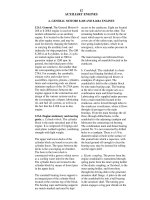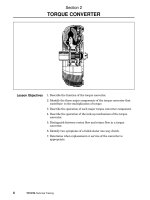Tài liệu PDA Robotics P2 docx
Bạn đang xem bản rút gọn của tài liệu. Xem và tải ngay bản đầy đủ của tài liệu tại đây (511.18 KB, 20 trang )
datagrams over an IP network. It is used primarily for broadcast-
ing messages over a network. In medical imaging, UDP is used to
log information from various devices to a system logging reposi-
tory. A datagram is a piece of a message transmitted over a pack-
et-switching network, and is a packet of information that con-
tains the destination address in addition to data.
• Channel 1: GPCLK/UART—This channel can be used as a general
purpose clock (GPCLK) or universal asynchronous receiver-trans-
mitter (UART). See Channel 3 for a more detailed description.
• Channel 2: Infrared Data Association (IrDA) is a group of device
manufacturers that developed a standard for transmitting data via
IR light waves. Increasingly, computers and other devices (such as
printers) come with IrDA ports. This enables you to transfer data
PDA Robotics
8
Figure 1.4
Block diagram of the Intel StrongARM SA-1110 microprocessor.
PDA 01 5/30/03 9:09 AM Page 8
from one device to another without any cables. For example, if
both your laptop computer and printer have IrDA ports, you can
simply put your computer in front of the printer and output a doc-
ument, without needing to connect the two with a cable.
IrDA ports support roughly the same transmission rates as tradi-
tional parallel ports. The only restrictions on their use are that
the two devices must be within a few feet of each other, and there
must be a clear line of sight between them. The IrDA port on the
PDA will be the main communication link to PDA-Bot; in
essence, it will be the spinal cord. PDA Robot responds to IrDA
discovery requests and identifies itself as “generic IrDA.” I decid-
ed to use an IrDA data link to the Robot because it is a very reli-
able communication link (error correction is built into it) that
requires absolutely no cables!
See: Chapter 4: Infrared Communications Overview, PDA Bot IR
transponder.
• Channel 3: Universal asynchronous receiver-transmitter (UART):
Intel provides a development board for the StrongARM SA-1100
microprocessors. It is interesting to note that most PDAs using
the StrongARM are almost identical in function to that of the
development board.
Increasingly, ARM-based microprocessors are being used in Palm OS
devices such as the Tungsten (see Figure 1.5). It has a Texas Instruments
OMAP1510 processor (an enhanced ARM-based processor).
The OMAP1510 processor includes the following:
• TI-enhanced ARM9 up to 175 MHz (maximum frequency).
• TMS320C55x DSP up to 200 MHz (maximum frequency).
• Voltage: 1.5v nominal.
• Optimized software architecture that allows designers to leverage
dual processing, and provides a complete and seamless software
foundation.
• DSP/BIOS Bridge that provides a seamless interface to the DSP
using standard APIs allowing easy access to DSP multimedia
algorithms.
Chapter 1 / Anatomy of a Personal Digital Assistant (PDA)
9
PDA 01 5/30/03 9:09 AM Page 9
• Open platform that enables a large network of independent
developers to provide a broad range of OMAP compatible soft-
ware solutions.
• LCD control/frame buffer for 16-bit QVGA display.
• USB client and host control.
• MMC-SD support.
• Bluetooth interface.
• USB, uWire, camera, and enhanced audio codec interface.
• Small, 289-pin MicroStar BGA package eases design in space-
constrained devices.
PDA Robotics
10
Figure 1.5
Palm OS Tungsten.
PDA 01 5/30/03 9:09 AM Page 10
To provide the optimal balance of high performance and low power
consumption necessary for these devices, the OMAP1510 combines
the TMS320C55x DSP core with a TI-enhanced ARM925 processor.
The ARM architecture is well suited for control-type code, such as the
operating system and user interface. The C55x DSP provides the addi-
tional processing power to handle the compute-intensive operations
such as security, multimedia, and speech. This is a great chip for
PDAs. Figure 1.6 shows the extensively integrated OMAP microchip.
A final example of a system on a chip design is the popular
MC68EZ328 (DragonBall EZ) Integrated Portable System Processor
used in many of the PDAs currently in use. Even though these proces-
sors typically run at a slower clock rate, they are capable of perform-
ing 2.7 MIPS performance at 16.58 MHz processor clock, and 3.25
MIPS performance at 20 MHz processor clock—very impressive for
their size and cost!
The second member of the DragonBall family, the MC68EZ328, inher-
its the display capability of the original DragonBall processor, but fea-
tures a more flexible LCD controller with a streamlined list of periph-
erals placed in a smaller package. This processor is mainly targeted for
portable consumer products, which require fewer peripherals and a
more flexible LCD controller. By providing 3.3 V, fully static operation
in efficient 100 TQFP and 144 MAPBGA packages, the MC68EZ328
delivers cost-effective performance to satisfy the extensive require-
ments of today’s portable consumer market. A number of the Visor
handspring PDAs utilize the Dragonball processors. Figure 1.7 is the
block diagram of the MC68EZ328.
Most PDAs have their small size and expandability in common,
regardless of the processor or operating system. In the near future, we
will likely see enough power in the palm of your hand to make the
desktop computer obsolete! The prices of even the high-end PDAs
have dropped dramatically over the last year, and will likely continue
to do so. There are slews of very low-cost, used PDAs floating around
at auctions, garage sales and in the classified ads. Even a very low-end
PDA running at least Palm OS version 1.1 will be sufficient for this
project. Look around if you don’t have one, and you will likely find a
very good deal on a used PDA.
Chapter 1 / Anatomy of a Personal Digital Assistant (PDA)
11
PDA 01 5/30/03 9:09 AM Page 11
12
DSP
MMU
OMAP5910
32
32
32
32
32
32
32 32
32
32
32
32
32
16
16
16
16
16
16
Flash and
SRAM
memories
SDRAM
memories
E
M
I
F
F
E
M
I
F
F
I
M
I
F
SRAM
1.5M bits
MPU
interface
Memory interface
traffic controller (TC)
JTAG/
emulation
I/F
MPU core
(TI925T)
(instruction
cache, data
cache, MMU)
ETM9
LCD
I/F
OSC
OSC
Clock and reset management
System
DMA
controller
12 MHz 32 MHz
Clock Reset External
clock request
MPU
peripheral
bridge
TMS320C55x DSP
(instruction cache, SARAM,
DARAM, DMA,
H/W accelerators)
MPU Bus
MPU private peripherals bus
MPU public
peripherals bus
DSP private
peripheral bus
McBSP1
McBSP3
MCSI1
MCSI2
DSP public (shared) peripheral bus
DSP
private peripherals
timers (3)
Watchdog timer
level 1/2
interrupt handlers
DSP public peripherals
MPU/DSP shared peripherals
TIPB
switch
UART1
UART2
UART3 IrDA
Mailbox
GPIO I/F
MPU private peripherals
Timers (3)
Watchdog timer
Level 1/2 interrupt
handlers
Configuration registers
Device identification
MPU public peripherals
McBSP2
USB Host I/F
USB Function I/F
I
2
C
µWire
Camera I/F
MPUIO
32-kHz timer
PWT
PWL
keyboard I/F
MMC/SD
LPG x2
Frame adjustment
counter
HDQ/1-Wire
RTC
Figure 1.6
Block diagram of an OMAP processor.
PDA 01 5/30/03 9:09 AM Page 12
Chapter 1 / Anatomy of a Personal Digital Assistant (PDA)
13
Figure 1.7
Block diagram of
the MC68EZ328.
PDA 01 5/30/03 9:09 AM Page 13
This page intentionally left blank.
15
PDA Robot consists of a robotic body and a PDA (handheld computer)
brain. This book will guide you through the creation of PDA Robot.
The project consists of mechanical, electronic, and software compo-
nents. Figure 2.1 shows PDA Robot roaming autonomously through
the house, capturing images when any motion is detected. The PDA
sitting on top is the machine’s main controller, receiving, analyzing,
and sending data to the robot body. The PDA is connected to a desk-
top computer that is monitoring the system, interpreting both data and
the video stream. The personal computer (PC) also acts as a control
station where the robot can be controlled remotely, based on the video
that is displayed.
The block diagram in Figure 2.2 is a high-level conceptualization of
PDA Robot. It doesn’t show the PDA connected to the wireless network.
Major Electronic Parts
Microchip MCP2150 IrDA
Standard Protocol Stack Controller
The MCP2150 is a cost-effective, low pin-count (18-pin), easy to use
device for implementing Infrared Data Association (IrDA) standard
wireless connectivity (see Figure 2.3). The MCP2150 provides support
for the IrDA standard protocol “stack” plus bit encoding/decoding.
Robotic
System
Overview
2
PDA 02 5/27/03 8:20 AM Page 15
Copyright 2003 by The McGraw-Hill Companies, Inc. Click Here for Terms of Use.









